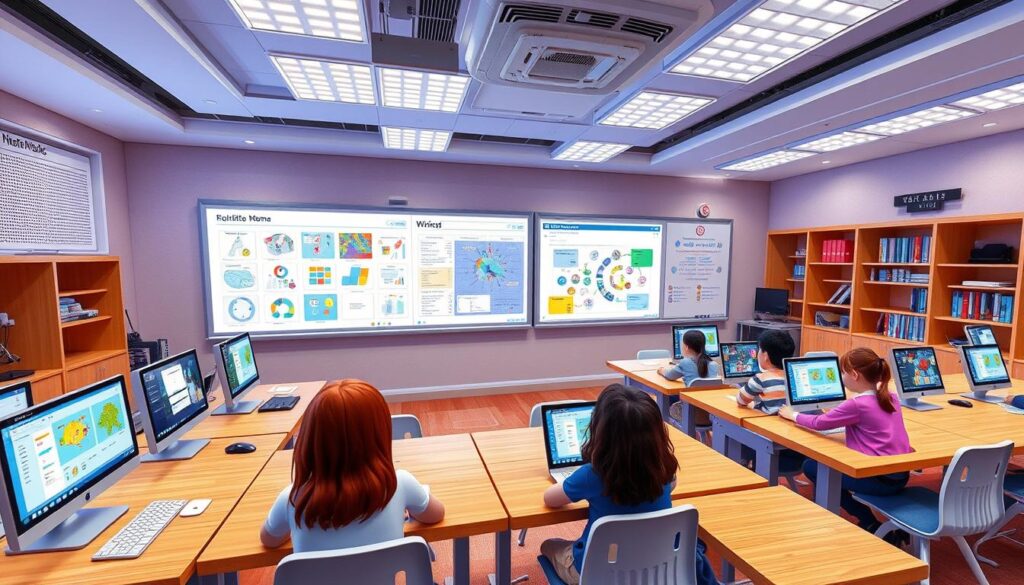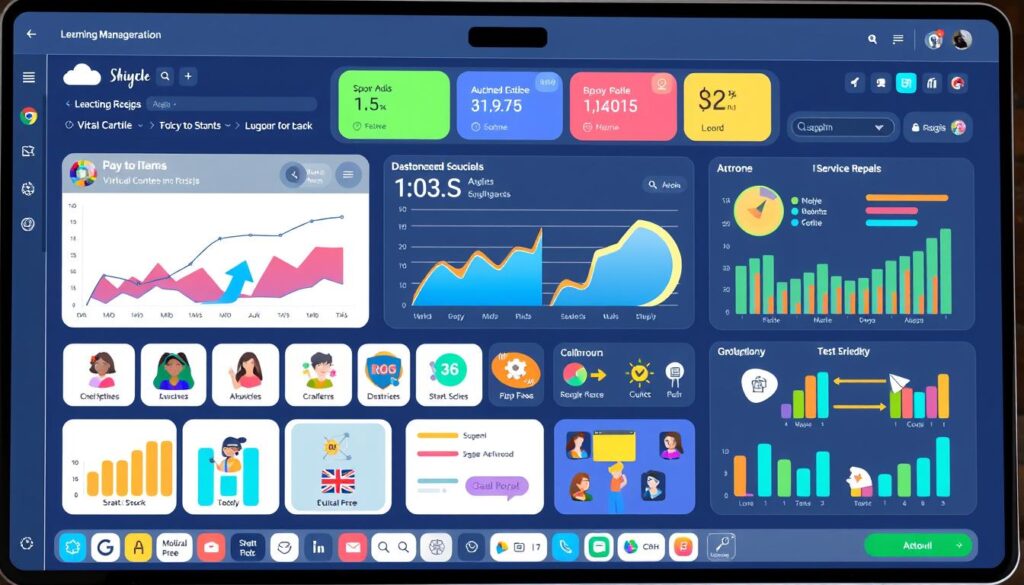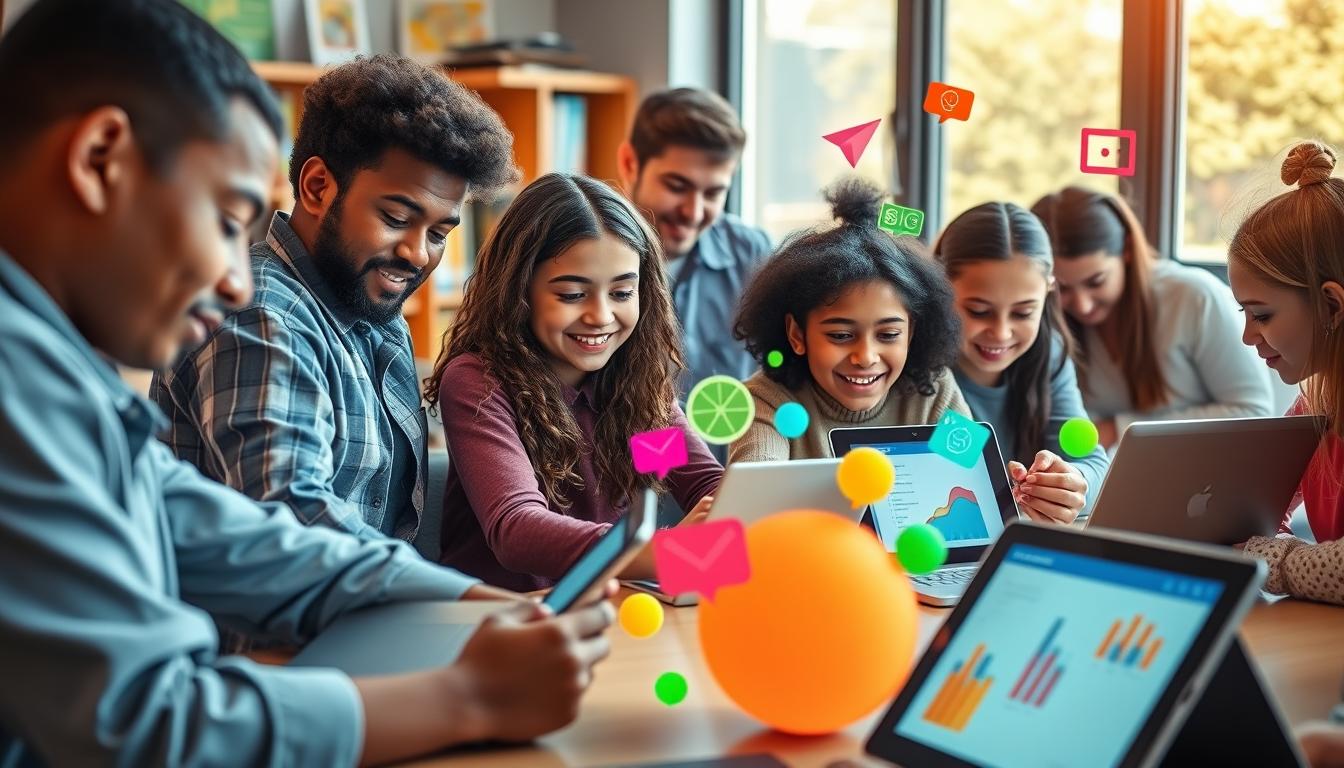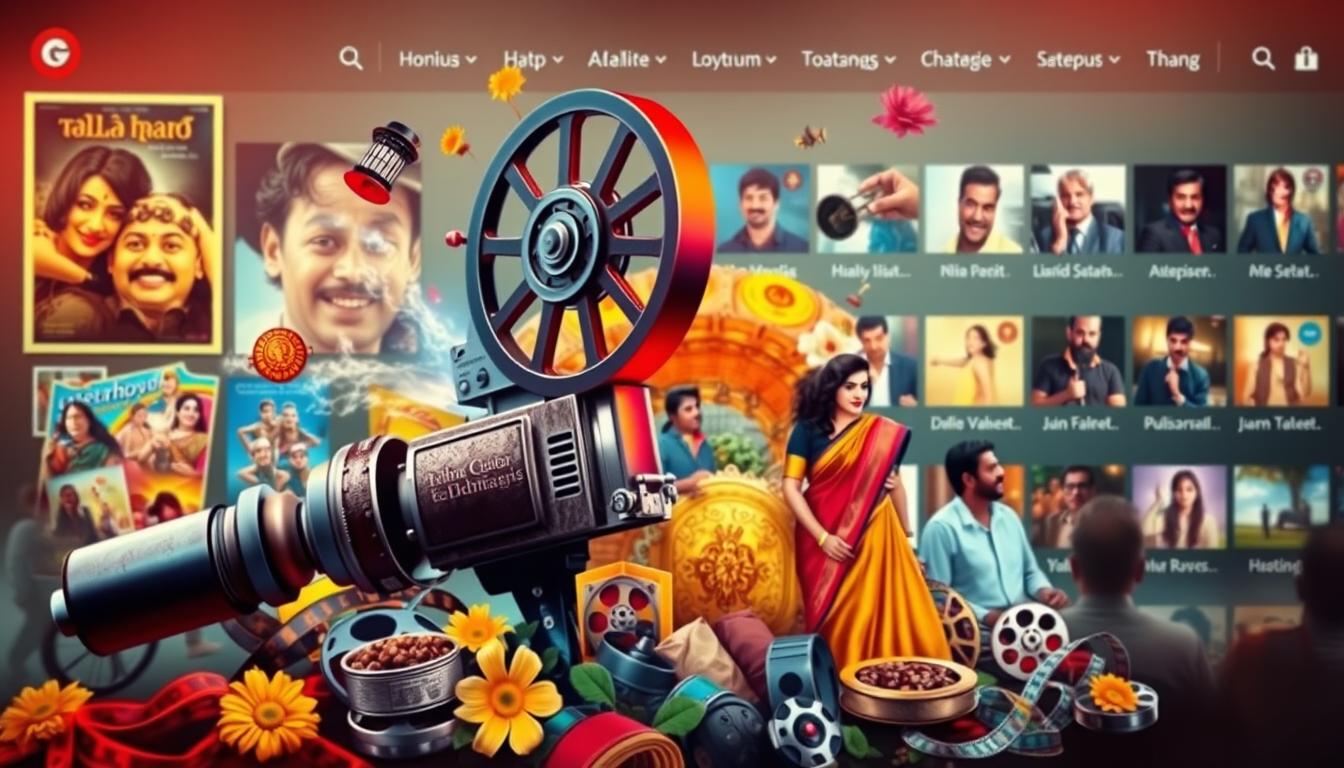In the ever-evolving landscape of education, one platform has consistently stood out as a beacon of innovation: Google Classroom. With its latest iteration, Google Classroom 6x, the tool has solidified its position as the premier online learning platform, offering a seamless and enriching experience for both educators and students. But what sets Google Classroom 6x apart from the rest? The answer may surprise you.
Have you ever wondered how this virtual classroom can transform the way we learn and teach? Studyvolt explores the remarkable features and benefits of Google Classroom 6x, unveiling its potential to revolutionize the educational landscape.
Key Takeaways
- Google Classroom 6x offers a comprehensive suite of tools for seamless online learning
- The platform’s intuitive interface and user-friendly features make it accessible to educators and students of all levels
- Integrated collaboration and communication tools foster engaging and interactive learning experiences
- Robust analytics and reporting capabilities enable teachers to track student progress and address learning gaps effectively
- Extensive integration with Google Workspace and third-party applications enhances the platform’s versatility and functionality
Overview of Google Classroom
In the ever-evolving landscape of educational technology and online education, one platform has emerged as a game-changer: Google Classroom. This innovative learning management system has revolutionized the way educators and students interact, collaborate, and navigate the world of digital learning.
What is Google Classroom?
Google Classroom is a free, web-based platform developed by Google that aims to simplify and streamline the educational process. It serves as a centralized hub where teachers can create, distribute, and grade assignments, while students can access course materials, submit their work, and engage in discussions.
Key Features of Google Classroom
- Seamless assignment management: Teachers can easily create, distribute, and grade assignments, reducing the administrative burden.
- Collaborative learning: Students can work together on group projects, share resources, and provide feedback to their peers.
- Real-time communication: The platform facilitates instant messaging, announcements, and notifications, fostering active engagement.
- Integration with Google Workspace: Google Classroom seamlessly integrates with other Google tools, such as Google Docs, Slides, and Drive, providing a comprehensive suite of digital resources.
Benefits for Educators and Students
Google Classroom offers a multitude of benefits to both educators and students. For teachers, the platform enhances productivity, streamlines grading and feedback, and promotes effective class management. For students, it fosters a collaborative learning environment, facilitates access to resources, and encourages active participation in the educational process.
“Google Classroom has been a game-changer in my teaching practice. It has allowed me to seamlessly manage my assignments, engage my students in meaningful discussions, and track their progress with ease.”
– Jane Doe, High School English Teacher
How Google Classroom Enhances Online Learning
In the era of digital collaboration and remote teaching, Google Classroom 6x has emerged as a game-changer in the world of online learning. By seamlessly integrating personalized learning experiences and a wealth of multimedia resources, this innovative platform has revolutionized the way students engage with educational content.
Personalized Learning Experiences
One of the standout features of Google Classroom 6x is its ability to tailor the learning experience to the individual needs of each student. The platform’s intuitive interface allows educators to create customized learning paths, ensuring that every student can progress at their own pace and explore content that aligns with their interests and abilities. This personalized approach not only fosters a deeper understanding of the subject matter but also cultivates a sense of ownership and engagement among students.
Integrating Multimedia Resources
Google Classroom 6x goes beyond traditional text-based learning by seamlessly integrating a wide range of multimedia resources. Educators can easily incorporate engaging videos, interactive simulations, and informative slide presentations into their online assignments and lessons, making the learning experience more dynamic and captivating for students. This integration of digital content not only enhances the visual appeal of the classroom but also caters to diverse learning styles, enabling students to better grasp and retain the material.
| Feature | Benefit |
|---|---|
| Personalized Learning Paths | Tailored to individual student needs and interests, fostering deeper engagement and understanding. |
| Multimedia Integration | Enhances the learning experience with engaging videos, simulations, and presentations, catering to diverse learning styles. |
By leveraging the power of personalized learning experiences and seamless multimedia integration, Google Classroom 6x has become a transformative tool for educators and students alike, revolutionizing the way digital collaboration, remote teaching, and online assignments are approached in the modern educational landscape.
Setting Up Your Google Classroom
Establishing a virtual classroom management system is essential for seamless online learning, and Google Classroom offers an intuitive platform to streamline this process. Whether you’re a teacher transitioning to an e-learning platform or a student seeking to optimize your digital learning experience, the step-by-step setup guide and customization options within Google Classroom can help you create a personalized and engaging virtual classroom environment.
Step-by-Step Setup Guide
- Sign in to your Google account and navigate to the Google Classroom homepage.
- Click on the “Create” button to begin setting up your virtual classroom.
- Fill in the necessary details, such as the class name, subject, and section, to create a unique identifier for your classroom.
- Customize the class stream, where you can share announcements, assignments, and other materials with your students.
- Invite students to join your classroom by generating a unique class code or sending individual invitations.
- Familiarize yourself with the various features and tools available within the Google Classroom interface to enhance your virtual classroom management.
Customizing Your Classroom Settings
To further optimize your Google Classroom experience, you can customize various settings to align with your teaching or learning preferences. This includes:
- Adjusting the classroom theme and aesthetics to create a visually appealing environment.
- Enabling or disabling specific features, such as the ability to post or comment, to suit your classroom dynamics.
- Integrating Google Workspace tools, like Google Drive and Google Meet, to leverage the full capabilities of the Google Classroom platform.
- Setting assignment due dates, grading scales, and other parameters to streamline the workflow for both educators and students.

By following these steps and customizing your Google Classroom settings, you can establish a well-organized and engaging virtual learning space that caters to the unique needs of your students or educational institution.
Engaging Students in Google Classroom
In the realm of online education, fostering student engagement is crucial for successful learning outcomes. Google Classroom offers a wealth of tools and strategies to enhance student engagement, from creating interactive assignments to leveraging the power of live virtual classes.
Interactive Assignments and Assessments
Google Classroom’s features enable educators to design engaging assignments that go beyond traditional written tasks. Teachers can incorporate multimedia elements, such as educational videos, interactive simulations, and gamified assessments, to keep students actively involved in the learning process. These interactive elements not only capture students’ attention but also promote deeper understanding and critical thinking.
Utilizing Google Meet for Live Classes
The integration of Google Meet with Google Classroom allows for seamless delivery of live virtual classes. Educators can leverage the interactive features of Google Meet, such as screen sharing, breakout rooms, and real-time collaboration, to create dynamic and engaging learning experiences for their students. This synchronous approach to online education fosters meaningful discussions, promotes active participation, and enables teachers to provide immediate feedback and support to their students.
| Interactive Assignments | Live Virtual Classes |
|---|---|
|
|
By leveraging the interactive features and live virtual class capabilities of Google Classroom, educators can create a dynamic and engaging learning environment that fosters student participation, enhances understanding, and supports the growth of essential 21st-century skills in the realm of online education.
“Effective online learning experiences are built on active engagement, meaningful interactions, and a sense of community – all of which can be achieved through the powerful tools and features of Google Classroom.”
Collaborating with Peers in Google Classroom
Google Classroom 6x takes online learning to new heights by fostering seamless digital collaboration among students. The platform’s robust features empower learners to work together on group projects, engage in thought-provoking discussions, and effortlessly share valuable resources and feedback, elevating the overall virtual classroom experience.
Group Projects and Discussions
Google Classroom’s collaborative tools make it easy for students to form teams, collaborate on online assignments, and share their progress in real-time. Students can actively participate in group discussions, exchange ideas, and provide constructive feedback, nurturing a dynamic and engaging learning environment.
Sharing Resources and Feedback
The platform’s file-sharing capabilities allow students to access and contribute relevant materials, fostering a collective knowledge base. Educators can also easily provide personalized feedback, guiding students in their learning journey and ensuring they receive the support they need to thrive.
“Google Classroom has revolutionized the way we approach digital collaboration in the classroom. The seamless integration of group projects and discussions has transformed the learning experience, empowering students to learn from one another and contribute to the collective growth of the class.”
By leveraging Google Classroom’s collaborative features, students can develop essential teamwork and communication skills, preparing them for success in the digital age. This holistic approach to learning not only enhances academic performance but also fosters the development of valuable soft skills, equipping students with the tools they need to excel in their future endeavors.
Tracking Student Progress in Google Classroom
As an essential feature of the learning management system, Google Classroom offers robust tools for educators to monitor and analyze student progress in the online education realm. By leveraging the data-driven insights provided by this educational technology platform, teachers can gain a deeper understanding of their students’ learning trajectories and identify areas that require targeted interventions.
Understanding Analytics and Reports
Google Classroom’s comprehensive analytics dashboard presents a wealth of information, empowering educators to make data-informed decisions. Teachers can access detailed reports on student engagement, assignment completion rates, and overall performance. These insights enable them to identify struggling learners and tailor their instructional strategies accordingly.
Addressing Learning Gaps Effectively
Armed with the analytical data, teachers can proactively address learning gaps and ensure that no student falls behind. By pinpointing areas where students are encountering difficulties, educators can provide personalized support, offer additional practice opportunities, and adjust their teaching methods to cater to the unique needs of each individual learner.
| Metric | Description | Benefit |
|---|---|---|
| Assignment Completion Rates | Tracks the percentage of students completing assigned tasks on time. | Helps identify struggling learners and areas where additional support is needed. |
| Student Engagement | Measures the level of student participation, such as posting in discussions or accessing course materials. | Provides insights into student motivation and participation, enabling targeted interventions. |
| Performance Trends | Analyzes student performance over time, highlighting areas of improvement or decline. | Enables teachers to track student progress and adjust their teaching strategies accordingly. |
By harnessing the power of Google Classroom’s analytics and reporting features, educators can gain a comprehensive understanding of their students’ learning progress and implement effective strategies to address any existing gaps. This data-driven approach empowers teachers to create more personalized and impactful learning experiences, ultimately fostering student success in the online education environment.

Google Classroom Integrations
As an e-learning platform, Google Classroom seamlessly integrates with a vast array of compatible apps and tools, empowering educators and students to leverage the power of educational technology and digital collaboration. By tapping into these integrations, teachers can enhance the learning experience, streamline classroom management, and foster a more engaging and interactive environment for their students.
Compatible Apps and Tools
Google Classroom’s open ecosystem allows educators to connect a wide range of third-party applications and tools, catering to diverse teaching and learning needs. From productivity suites like Google Workspace to multimedia creation tools, video conferencing platforms, and assessment platforms, the integration possibilities are extensive. By incorporating these complementary resources, teachers can create a more dynamic and personalized learning experience for their students.
- Google Workspace (Docs, Sheets, Slides, etc.)
- Video Conferencing Tools (Google Meet, Zoom, etc.)
- Content Creation Apps (Adobe Creative Cloud, Canva, etc.)
- Assessment and Feedback Tools (Quizlet, Kahoot!, etc.)
- Project Management and Collaboration Apps (Trello, Asana, etc.)
Leveraging Google Workspace Features
Google Classroom’s tight integration with the broader Google Workspace ecosystem empowers educators to unlock a wealth of features and functionalities to support their teaching and learning objectives. By seamlessly incorporating Google Workspace tools such as Docs, Sheets, and Slides, teachers can foster collaborative learning, facilitate real-time feedback, and encourage students to engage in interactive projects and assignments.
| Google Workspace Tool | Classroom Integration Benefit |
|---|---|
| Google Docs | Collaborative document editing, real-time feedback, and version tracking |
| Google Sheets | Data analysis, visualization, and shared spreadsheet collaboration |
| Google Slides | Interactive presentations, multimedia integration, and group project development |
By seamlessly integrating compatible apps and leveraging the full capabilities of Google Workspace, educators can create a rich and engaging e-learning platform that fosters educational technology and digital collaboration within their Google Classroom environment.
Best Practices for Teachers Using Google Classroom
As remote teaching and virtual classroom management become increasingly prevalent in modern online education, teachers must adapt their strategies to create inclusive learning environments that actively engage students. Google Classroom, a powerful platform for remote teaching and online education, offers a wealth of features to help teachers foster interactive and collaborative virtual classrooms.
Creating Inclusive Learning Environments
To ensure all students feel welcomed and supported in the virtual classroom management, teachers should:
- Implement universal design for learning principles, offering multiple means of representation, expression, and engagement.
- Provide clear instructions and guidelines, catering to diverse learning styles and abilities.
- Encourage open communication and foster a sense of community among students.
Encouraging Student Participation
Keeping students actively engaged in the online education experience is crucial for effective learning. Teachers can leverage Google Classroom’s features to:
- Incorporate interactive assignments, such as quizzes, discussions, and collaborative projects.
- Utilize Google Meet for live, interactive class sessions that promote real-time discussion and feedback.
- Provide timely feedback and personalized guidance to support student progress.
By implementing these best practices, teachers can create dynamic and inclusive virtual learning environments that empower students to thrive in the ever-evolving landscape of remote teaching and online education.
| Best Practices | Benefits |
|---|---|
| Inclusive Learning Environments | Ensuring all students feel welcomed and supported in the virtual classroom |
| Encouraging Student Participation | Keeping students actively engaged in the online education experience |
“The key to effective remote teaching is creating an inclusive and engaging virtual learning environment that caters to the diverse needs of all students.”
Future of Google Classroom in Education
As the educational landscape continues to evolve, the future of Google Classroom in the realm of online learning platforms holds immense potential. Educators and students alike are eagerly anticipating the ongoing trends and innovations that will shape the platform’s development in the years to come.
Trends in Online Learning Platforms
The world of e-learning has witnessed a surge in personalized and adaptive learning experiences, catering to the diverse needs of individual students. Google Classroom is poised to capitalize on this trend, leveraging its robust integration with Google’s suite of educational tools to offer tailored learning pathways and content recommendations. Additionally, the growing emphasis on collaborative learning and real-time feedback is expected to be further amplified within the Google Classroom ecosystem.
Innovations on the Horizon for Google Classroom
Educators and developers are collaborating to introduce groundbreaking features that will revolutionize the way Google Classroom is utilized in the classroom and beyond. Anticipated innovations include advanced analytics and learning analytics, enabling teachers to gain deeper insights into student performance and tailor their instruction accordingly. The integration of artificial intelligence and machine learning is also on the horizon, potentially automating grading, providing personalized study recommendations, and streamlining administrative tasks. As Google Classroom continues to evolve, its seamless integration with emerging technologies will undoubtedly enhance the overall educational experience for both teachers and students.




